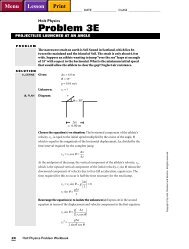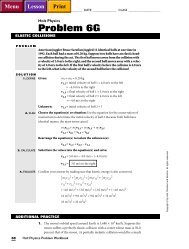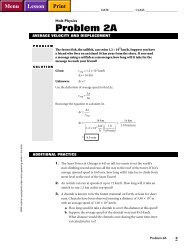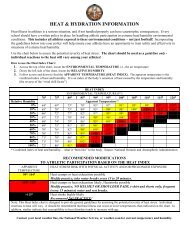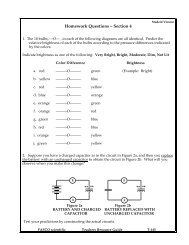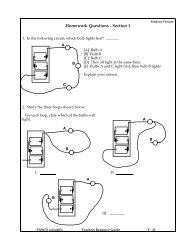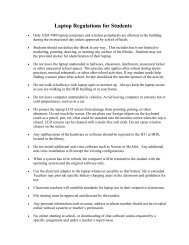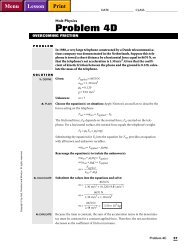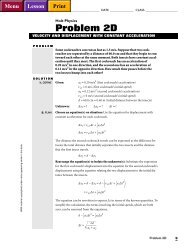Kinematics Practice with Calculus - Differentiation - Hays High School
Kinematics Practice with Calculus - Differentiation - Hays High School
Kinematics Practice with Calculus - Differentiation - Hays High School
- No tags were found...
You also want an ePaper? Increase the reach of your titles
YUMPU automatically turns print PDFs into web optimized ePapers that Google loves.
AP Physics C - MechanicsUnit 1 KINEMATICS<strong>Kinematics</strong> <strong>Practice</strong> <strong>with</strong> <strong>Calculus</strong> - <strong>Differentiation</strong>1. The position of an object moving along a straight line is given by x = 3 - 2t 2 + 3t 3where x is in meters and t in seconds. SHOW ALL WORK and/or EXPLAIN IN DETAIL!a) Derive the expressions for the velocity and acceleration of the object as a function of time.(v = -4t + 9t 2 , a = -4 + 18t)b) Find the position of the object at t = 0, t = 2s, t = 4s. (3m, 19m, 163m)c) Find the displacement or the object between t = 2s and t = 4s; between t = 0s and t = 4s.(144m, 160m)d) Find the average velocity between t = 2s and t = 4s; between t = 0s and t = 4s;between t = 1s and t = 3s.(72m/s, 40m/s, 31m/s)e) What is the instantaneous velocity at t = 2s? at t = 5s? (28m/s, 205m/s)f) At what time(s) is/are the instantaneous velocities zero? (0s, 0.44s)17
AP Physics C - MechanicsUnit 1 KINEMATICSg) When does the instantaneous velocity have a maximum or a minimum value? (0.22s)h) Find the change in velocity between t = 2s and t = 5s. (See part e) (177m/s)i) Find the average acceleration between t = 2s and t = 5s; between t = 1s and t = 3s.(59m/s 2 , 32m/s 2 )j) When is the instantaneous acceleration of the object zero? (0.22s)k) Find the instantaneous acceleration of the object at t = 2s; t = 5s. (32m/s 2 , 86m/s 2 )18
AP Physics C - MechanicsUnit 1 KINEMATICS2. The position of a body moving along a straight line is given by x = 16t - 6t 2where x is in meters and t in seconds.a) Find the position of the body at t = 1s. (10m)b) At what times does the body pass the origin? (0s, 2.67s)c) Calculate the average velocity of the body between t = 0 and 2 seconds. (4m/s)d) Find the velocity of the object at any time t. (v = 16 - 12t)e) What is velocity at t = 0? at t = 2s? (16m/s, -8m/s)f) At what times and positions will the body be at rest? (1.33s, 10.6m)g) Find the acceleration of the body at any time t. (-12m/s 2 )h) When is the acceleration of the body zero? (never)19
AP Physics C - MechanicsUnit 1 KINEMATICSi) Using the data calculated from a-h, plot a vs t, v vs t, and x vs t.a (m/s 2 )t (s)v (m/s)t (s)x (m)t (s)j) During what time interval(s) is the body “speeding up” (i.e. accelerating)? ( t > 1.33s)k) During what time interval(s) is the body “slowing down” (i.e. decelerating)? (0 < t < 1.33s)20




